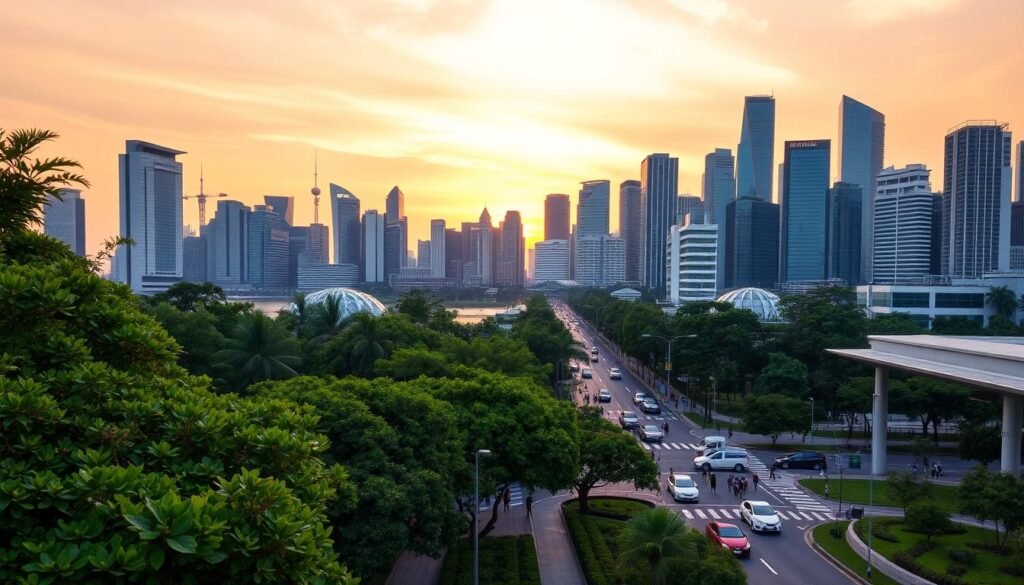Surprising fact: Singapore records daily highs between 77–88°F almost all year, and humidity often sits near 75%, so heat shapes every plan more than a calendar.
I’ll help you pin down the single clearest rule for planning: match your travel style to the city’s rhythm. I explain how the heat and monsoon swings affect outdoor shows, indoor attractions, and crowd levels so you can pick when to go without guesswork.
Practical note: May–June pushes the mercury higher, November–January brings lingering monsoon rains, and February–April feels most pleasant. July–September lights up with festivals and sales, which change crowds and prices.
Pack light clothing, comfy walking shoes, sun protection, and rain gear for the wetter months. I rely on the MRT to move fast and stay cool; it’s clean, efficient, and a small strategy that saves time and energy in the heat.
Key Takeaways
- Singapore stays hot and humid year-round; plan for shade and breaks.
- Feb–Apr is the most pleasant stretch for outdoor plans.
- Monsoon rains peak Nov–Jan; pack rain gear then.
- Festivals July–Sep raise crowds and create lively moments.
- Use the MRT to beat heat and move between attractions easily.
- Pack light and plan a flexible schedule for quick showers.
Your quick answer: When I think the best time to visit Singapore is
If I had to pick one window that feels easiest for most travelers, I’d aim for late February through April. I find that stretch breezier between the hotter May–June weeks and the heavier monsoon rains from November–January.
How I plan my days: I set open-air activities for late afternoons and evenings when the sun eases. For early afternoons I always keep an indoor backup — a museum, mall, or air-conditioned cafe.
Handling quick showers: I time outdoor slots after predicted downpours and use short MRT hops to stay dry. That makes muggy hours far more comfortable and keeps my schedule flexible.
- I pivot to July–September when I want festival energy, knowing crowds and prices rise.
- I build light, loose daily plans so the weather can flex without ruining the day.
- The months you choose affect dining pace, sightseeing tempo, and evening waterfront shows.
Quick expectation: There’s no bad choice, but picking the right months for your style makes the whole trip smoother.
Singapore weather at a glance: Hot, humid, and dependable year-round
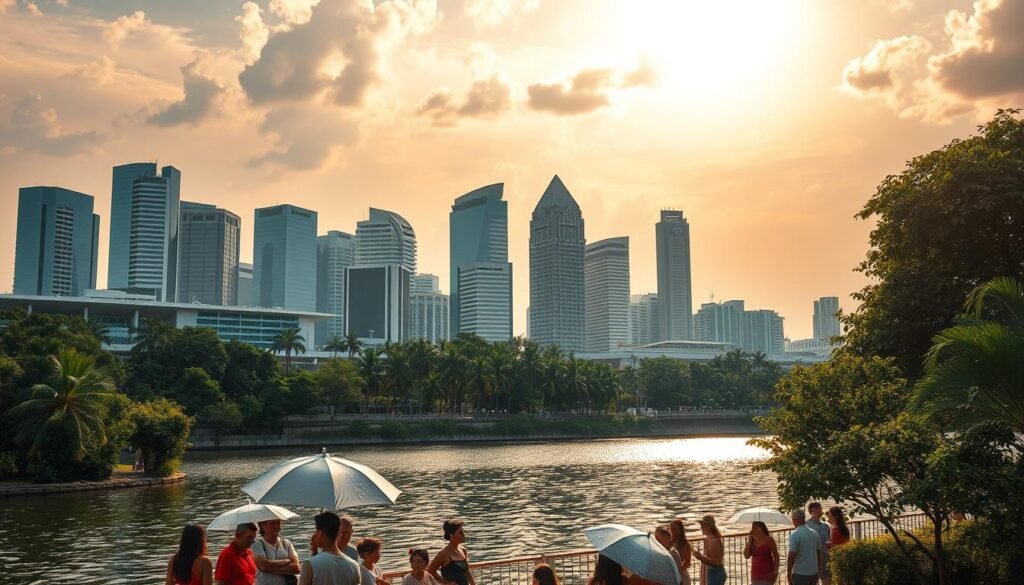
Quick snapshot: I treat this city as reliably tropical — warm days, thick air, and many short showers. The basic numbers matter, but I plan around how they feel.
Temperatures and humidity you can expect
Average temperatures sit around 77–88°F, and humidity typically runs near 70–80%. That mix makes the heat feel stronger than the thermometer shows.
May–June can spike into the high 90s°F, so I shift outdoor plans to mornings or evenings then. I also carry a small towel and pick breezier waterfront routes when I need a break.
Rainfall patterns and the monsoon window
Rain can fall any day, but showers often cluster in late afternoons. The wettest window is November–January, when rain may linger longer and indoor options shine.
- I keep light rain gear on hand and use short MRT hops to stay dry.
- I favor museums and food halls during the monsoon and take regular water breaks to beat the hot humid feel.
best time to visit singapore
I plan trips around the calm stretch between the heavy rains and the hottest spikes.
Why February to April often feels just right
February–April gives me more pleasant mornings and cooler evenings. I line up outdoor activities like Sentosa Island and the Singapore Zoo in early slots.
I time beach or park moments for late afternoons, then cap days with waterfront light shows or the night safari. That keeps heat from draining the fun.
What to expect July to September during festival season
July–September brings festivals and citywide events that raise energy and crowds. I buy advance tickets and start early to beat lines.
I build a loose daily plan that assumes a quick shower. Hydration breaks and shaded stops keep museum or mall backups handy.
“I pair outdoor hours with cooling breaks so the weather never steals the fun.”
| Feature | Feb–Apr | Jul–Sep |
|---|---|---|
| Ideal activities | Beaches, parks, morning zoo visits | Festivals, events, evening shows |
| Crowds & energy | Moderate, relaxed | High, vibrant |
| Practical tip | Plan outdoor slots early; pack water | Book tickets early; dine outside peak heat |
Choose comfort-first or event-forward: I pick February–April for ease and July–September when I want color and crowds. Either way, short plans and an umbrella keep the trip flexible.
Month-by-month guide: What each part of the year feels like
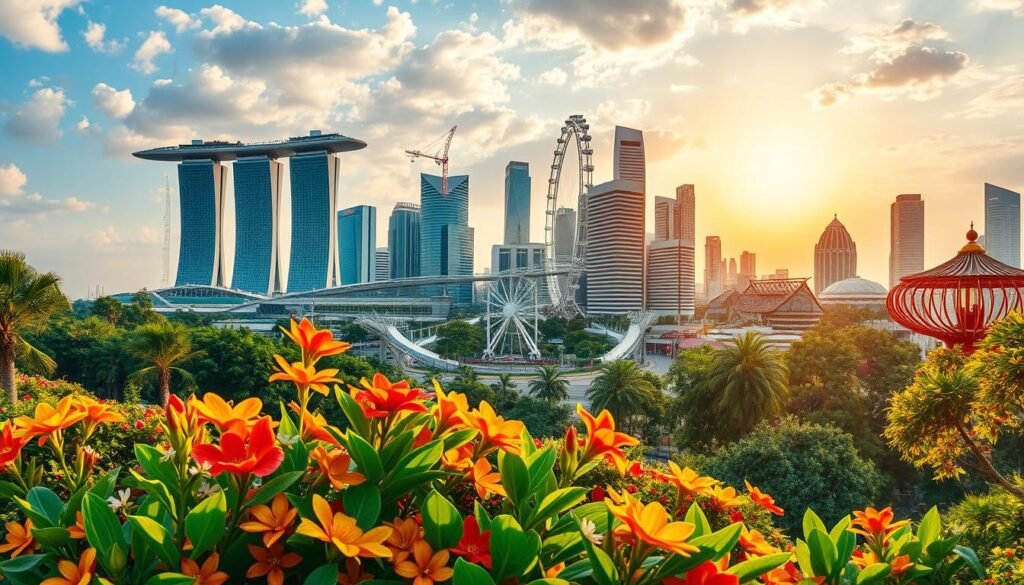
I walk through each month so you can picture how the weather shapes plans across the year.
December–January: Wettest stretch
What I feel: Rain is common and showers can linger. Breezes feel slightly cooler, which helps the heat a bit.
I favor museums and food halls, and I keep outdoor slots flexible in case of prolonged rainfall.
February–April: Pleasant and outdoorsy
Why I like it: These months singapore give clearer skies and gentler temperatures. There are plenty of outdoor activities and beach time.
May–June: Hottest weeks
Temperatures often climb into the high 90s°F. I plan major attractions for early morning or late evening and use malls for midday breaks.
July–September: Festival season
Energy spikes with events and sales. I book tickets early and arrive before peak lines when a season’s big shows roll through.
October–November: Shoulder weeks
Rains start shifting toward the wettest months. I watch the forecast closely, carry an umbrella, and swap plans fast if rain arrives.
“I tune plans to temperatures and rainfall, not just dates — that keeps every month workable.”
| Period | Feel | Weather notes | My tip |
|---|---|---|---|
| Dec–Jan | Indoor-forward | High rainfall, cooler breezes | Book museums; flexible outdoor slots |
| Feb–Apr | Outdoor-friendly | Clearer skies, milder temperatures | Plan parks, zoo, beaches early |
| May–Jun | Hot and humid | Peak temperatures, brief rain | Early starts; indoor midday |
| Jul–Nov | Festive to transitional | Events then shifting rainfall | Secure event tickets; carry umbrella |
Events, food, and shopping: Timing your trip around what you love
![]()
C. My approach is simple: pick a few must-do events, then stitch shopping and food stops between them for low-stress days.
Great Singapore Sale runs June–August and is where I build a shopping-first itinerary.
I hit Orchard Road anchors early, then pivot to VivoCity or Marina Square for variety and lower lines. I book key items ahead and use mall lockers when I need lighter walking.
Singapore Food Festival: eating your way through the city
For the Singapore Food Festival I sample hawkers by day and book special menus at night.
I leave gaps for palate recovery, add one guided tour to speed up discovery, and revisit favorites the next day.
Other festivals and practical tips
July–September brings the liveliest events. I lean into that buzz but start days earlier to avoid crowds.
- I use the MRT to hop air-conditioned between malls and dining hubs.
- I map a flexible “sale-and-snack crawl” linking shops with nearby hawker centers.
- Evenings I switch from late-afternoon shopping to waterfront dinners at Clarke Quay or Marina Bay.
“A little planning turns a shop-and-eat sprint into a relaxed city crawl.”
Outdoor vs. indoor days: How I plan around heat, humidity, and showers
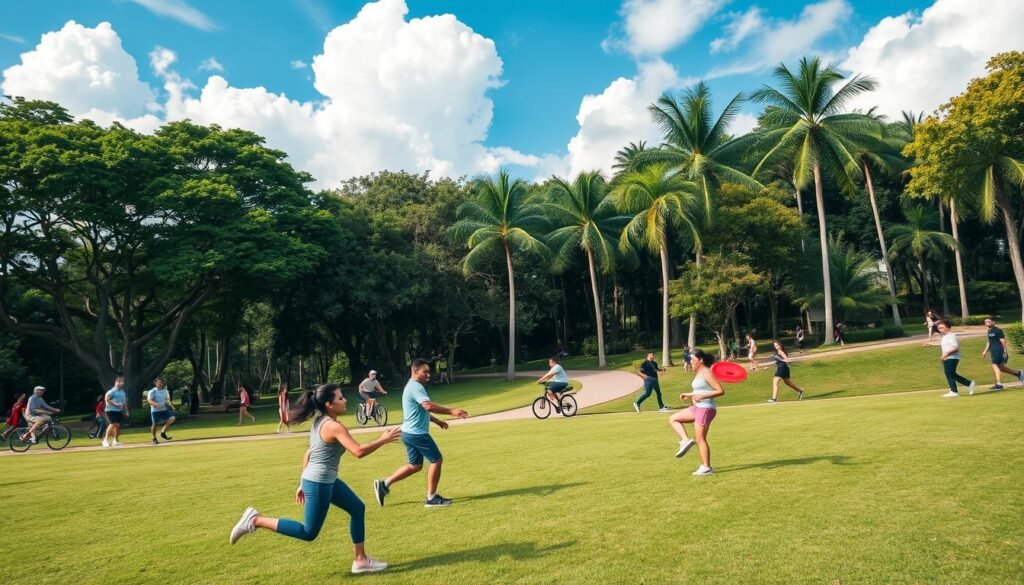
My daily rule is simple: I take outdoor slots when the air cools and keep indoor fallbacks for the steamiest hours.
I plan outdoor activities for early mornings and late afternoons, then move inside during the peak hot humid part of the day.
Best months for outdoor activities, beaches, and evening strolls
When skies cooperate, I aim my beach visits and waterfront walks for evening hours. Sunsets bring a breeze that makes the city feel more relaxed.You can learn more best-time-to-visit-scotland
Top indoor picks for steamy afternoons: Museums, malls, and more
My go-to indoor resets are the National Gallery Singapore, the ArtScience Museum, and the big Orchard Road malls. They offer cool air, culture, and food when humidity is high.
I watch radar and cloud cover on my phone. If showers look likely, I swap an open-air stroll for a museum or a coffee break and slide the outdoor activity later.
| Plan element | When I do it | Why it works |
|---|---|---|
| Morning outdoor activities | Before 10 AM | Cooler temps, lower humidity for parks and trails |
| Midday indoor reset | 11 AM–3 PM | Museums, malls, and air-conditioned dining to avoid hottest hours |
| Evening beaches & strolls | After 5 PM | Breezes pick up, great light, fewer crowds |
| Quick plan swaps | Any time | Radar checks, MRT hops, and nearby indoor backups stop showers from ruining days |
“I split my days so the weather shapes where I go, not whether I go.”
Sample rhythm I use: morning park or zoo, midday museum or mall, late afternoon coffee, then evening waterfront. The MRT is my chilled lifeline between spots.
Neighborhoods and icons: When I like to visit top attractions
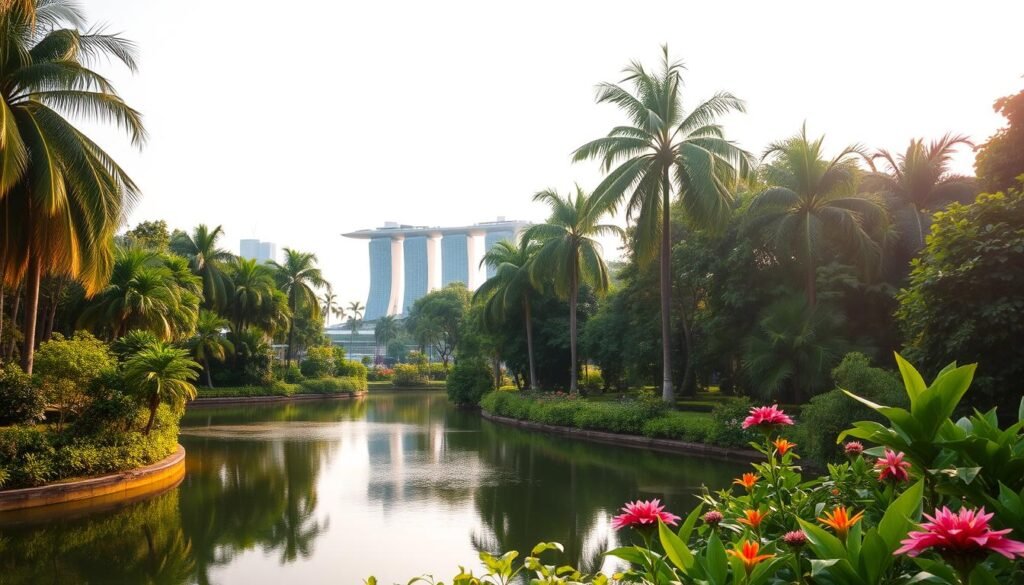
My approach is simple: match each icon with the part of day that shows it best. That keeps energy up and lines down while I see more of the city.
Gardens by the Bay and Marina Bay
I plan gardens bay visits for the evening when the Supertrees light up. The air cools and the displays feel magical.
After the show I stroll along marina bay for skyline views and calmer breezes. It’s a smooth transition from glowing gardens to waterfront light shows.You can learn more best-time-to-visit-hawaii
Sentosa Island
sentosa island bundles beaches, Universal Studios, and other attractions in one spot. I batch thrills in the morning, rest in shade midday, then return for sunset by the shore.
A monorail or cable car makes moving around easy, and snack breaks keep the day breezy.
Orchard Road and shopping
orchard road is my weather-proof base for shopping. I use malls for long breaks, underground links to skip rain, and quick shops between museum hops.
Singapore Zoo and wildlife
I hit the singapore zoo at first light with refillable water and a hat. Early hours are cooler and animals are active.
For a cooler, atmospheric night, I save the Night Safari as an alternative.
National Gallery and museums
The national gallery and nearby museums are perfect when rain shows up. I slip between galleries, enjoy rotating exhibits, and keep outdoor time short and sweet.
“Evenings for waterfronts, mornings for wildlife, and all-day for shopping districts—match the window and the attraction rewards you.”
Travel styles: My picks for families, couples, and solo travelers
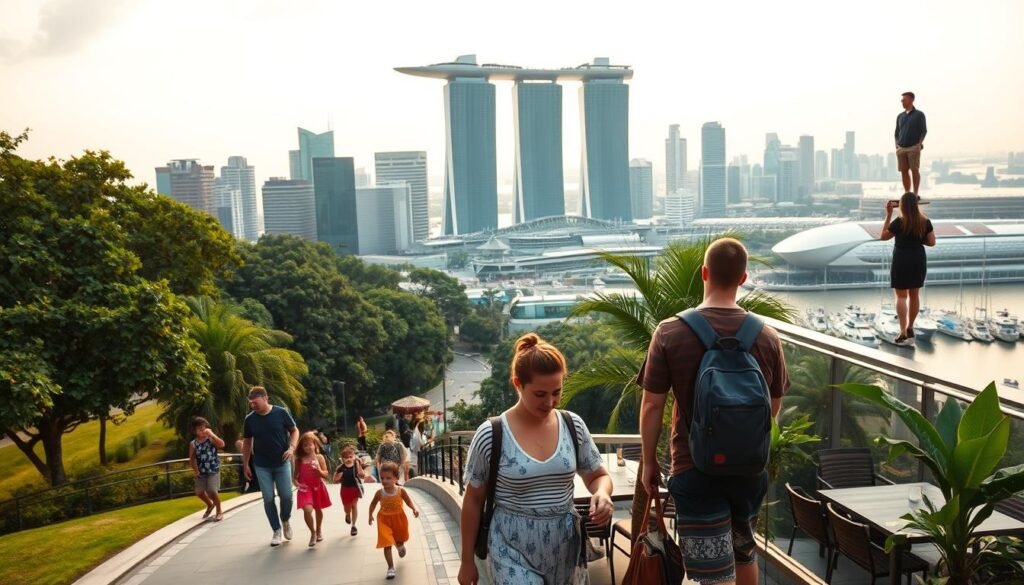
I sort my travel plans by who I travel with, then pick months that make the days easy. That approach keeps weather and crowds from dictating the fun.
With kids: February to April sweet spot
Why I choose these months: Feb–Apr offers milder mornings and calmer afternoons. Parks, Sentosa, and open-air gardens work well for small legs and naps in transit.
I pace days with early starts, midafternoon cool-downs, and short MRT hops so kids stay rested.
For couples: Romantic seasonality and crowd hacks
Couples get a special mix from December through February. Cooler breezes and festive lights make evenings feel romantic.You can learn more best-places-to-visit-in-mexico
Crowd hacks: prebook headline shows, dine off-peak, and time waterfront walks for sunset views.
Solo trips: December to June flexibility
I find December–June gives solo travelers the most freedom. You can anchor a marquee sight, then improvise museums and food stops by mood.
Neighborhood fit: Sentosa for families, Marina Bay evenings for couples, and museum clusters for solo explorers.
| Travel style | Ideal months | Quick tip |
|---|---|---|
| Families | february april | Early mornings, parks, short MRT hops |
| Couples | Dec–Feb | Prebook shows, sunset waterfront walks |
| Solo | Dec–Jun | Anchor one sight, improvise meals and galleries |
“Match the months to who you travel with and the city rewards you with smoother days.”
Budget and crowds: Finding deals without missing the buzz
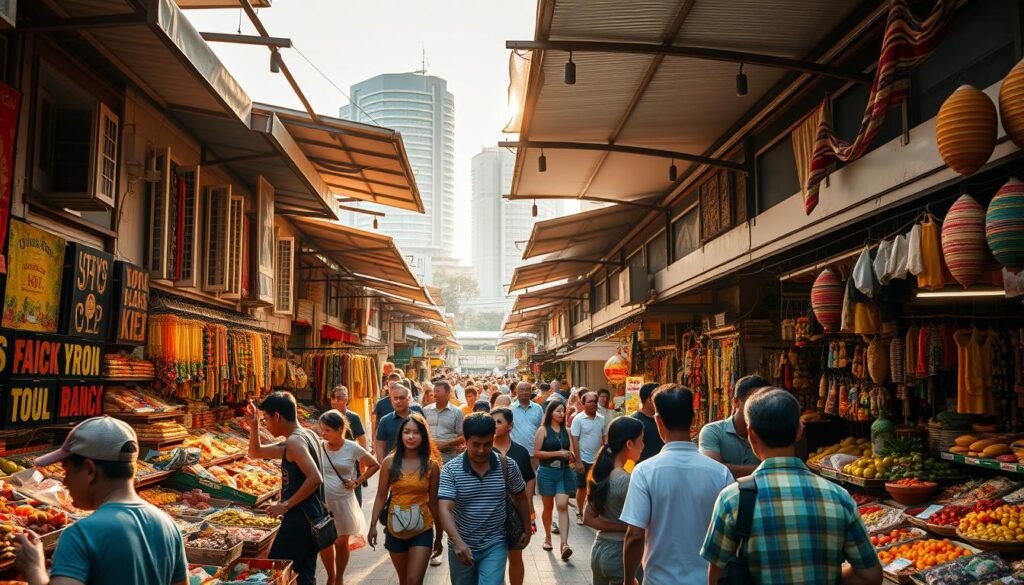
I watch event calendars and rainfall charts together — that’s how I find deals without missing the buzz. July–September often brings festival energy and higher demand, so I aim to lock key plans early.
High season: July through September energy and how I save
Why it spikes: Major events and sales draw crowds and push room rates up. I still save by booking flights and headline tickets early and keeping at least one cancellable hotel reservation.
My trick: I buy event tickets, then stagger nonrefundable nights so I keep flexibility and a low price point.
Cheapest windows and shoulder months I watch
March often offers shoulder deals after peak festival booking windows. July–August sales can also yield shopping bargains if you time malls and shops on weekday mornings.
How weather affects hotel rates and flight prices
Wet months (Nov–Jan) usually soften hotel rates. The hottest stretch (May–Jun) can push dynamic pricing for indoor attractions and rooms with pools.
- Lock flights early, hold cancellable rooms, then pounce on promos.
- Pick off-core neighborhoods near an MRT line for better value.
- Small savings add up: tap cards for transit, refill bottles, and eat off-peak.
| Factor | Effect | My tip |
|---|---|---|
| Events & festivals | Higher prices, sold-out nights | Book tickets early; mix refundable nights |
| Shoulder months | Lower rates, more promos | Watch March and late-August windows |
| Weather | Rainy = softer rates; hot = dynamic pricing | Shift outdoor plans to evening to cut costs |
“I balance buzz and bargains by securing essentials early and staying flexible on the rest.”
What to pack and how I get around

I pack with purpose: breathable fabrics, sun protection, and a small rain shield for unexpected weather. My kit keeps days flexible and lets me enjoy the city without being slowed by heat or sudden showers.
Clothing checklist for heat, humidity, and rain
Clothing choices matter. I bring light, loose tees, quick-dry shorts, and one pair of comfortable walking shoes.
I carry a thin change layer so I can rotate outfits when temperatures rise and humidity bites.
Sun, rain, and comfort gear I never skip
Non-negotiables: a broad-spectrum sunscreen, a wide-brim hat, and sunglasses. I stash a compact umbrella or packable shell for short rain bursts.
- Breathable tops and quick-dry bottoms.
- Strong sunscreen, hat, and a small towel.
- Compact rain kit that turns showers into a short pause.
- Electrolytes, a power bank, cable organizer, and a foldable tote.
Why I rely on the MRT to beat heat and showers
The MRT is clean, cool, and fast. I use it to cross the city, jump between attractions, and avoid long wet walks during sudden rain.You can learn more best-time-to-visit-spain
“A light pack and an MRT card keep my days moving without extra weight or worry.”
Sample timing playbook: How I’d plan a trip by month range

Quick intro: I lay out four compact, plug-and-play mini-itineraries that match weather, crowds, and energy across the year. Each plan shows when I start the day, which afternoon fallbacks I use, and how I close with an evening slot that feels right.
Feb–Apr: Culture, food, and outdoor highlights
I build mornings around green spaces and the Singapore Zoo at first light. Mid-morning I slip into galleries and food halls for culture and lunch.
Evenings are for waterfront dining and light shows. This window favors parks, museums, and gentle outdoor activities.
May–Jun: Heat-smart itineraries and evening tours
My days start early. I use museum-heavy middays, shaded lunches, and short indoor breaks when the sun peaks.
After the sun dips, I join guided evening tours or night markets that bring the city to life without the worst heat.
Jul–Sep: Festival-forward days with indoor interludes
I prebook marquee events and sprinkle indoor interludes between performances. That keeps afternoons calm and evenings vibrant.
Late-night skyline stops and cooled malls make it easy to move from festival stages to quieter dinner spots.
Oct–Jan: Crowd-light strategies and rainy-day gems
When showers creep in, I block museum hours and hawker crawls into my schedule. Flexible park breaks slip in during brief dry windows.
This range rewards timed starts, a recovery day mid-trip, and an eye on radar so showers become chance for indoor discovery.
| Month range | Morning | Midday | Evening |
|---|---|---|---|
| Feb–Apr | Gardens, Singapore Zoo (early) | Museums, food halls | Waterfront dining, light shows |
| May–Jun | Early starts, beach strolls | Air-conditioned museums, shaded lunches | Guided evening tours, night markets |
| Jul–Sep | Prebooked events (early arrival) | Indoor interludes, malls | Festival nights, skyline views |
| Oct–Jan | Flexible starts for dry spells | National Gallery blocks, hawker crawls | Museum evenings, low-crowd strolls |
“I keep days flexible: early starts, cool middays, and evening slots that reward patience.”
Conclusion
,
Match your goals—outdoor days, festivals, or quiet shopping—and the calendar becomes an asset, not a guess.
I find February–April often balances milder temperatures and clearer skies, while July–September brings festival energy across the city. Evenings at Marina Bay and the Gardens are cooler and very photogenic.
On hot or rainy days I lean on Orchard Road and the National Gallery for shelter, food, and indoor discoveries. Pack light layers, broad-spectrum sunscreen, and a compact umbrella, and use the MRT for quick, cool hops between spots.
Choose a few must-do things, spread them across days, and leave room for side streets and stalls. Follow these simple tactics and you can visit singapore any year and still have a great trip.


